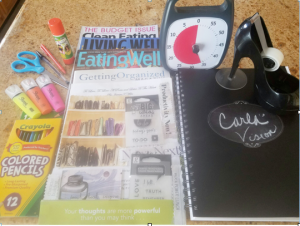NAPO Member, Jan Lehman shares her “10 Weeks of Productivity” during NAPO GO Month. #GOMonth2018

In order to be productive, it’s important to understand what productivity means at its roots. Over the next 10 weeks, we are going to define productivity by breaking it down into the 10 most effective actions practiced by highly productive professionals.
Before we start with this week’s topic, here are some basic productivity concepts to get you started on your path to a more productive workday.
Productivity is about quality and value, not quantity and volume.
Productivity relates to the accomplishments in your day that have meaning and purpose.
Productivity is about achieving an end result that possesses integrity and value.
Productivity is about maximizing your most important resources: Time, Technology and Talent.
Productivity is about giving you more time and energy for the people and activities in your life that bring you joy.
Over the next 10 weeks, we’ll take a deeper look into the following topics leading you to optimal productivity. Let’s get started!
WEEK 1: DEFINE YOUR ISSUES AND GOALS
GOT ISSUES
Let’s face it. You’ve got issues. We all do. Whether you’re the CEO of a multi-million dollar corporation or a part-time employee of a non-profit organization, you have things that could be running more smoothly. Now that we have that out in the open, let’s figure out just what those issues are, and how they’re impacting your productivity.
DEFINE “DEFINE”
Defining your issues isn’t as simple as it may seem. It’s easy to point fingers at the people and processes that slow us down, but are they the real problem? I recently had a client (we’ll call him Bob) come to me with an issue. His employee (we’ll call him Joe) had an email problem. Joe just couldn’t seem to respond to email in a timely manner. His inbox was always overflowing, and requests were piling up. Bob hired me to coach Joe on how to manage his email more efficiently.
After spending several hours of Joe’s day walking through email management efficiencies, I was enlightened to find that Joe knew perfectly well how to manage his inbox. Email wasn’t Joe’s issue. Bob had failed to define the issue.
After taking a step back and observing Joe carry on with the to-dos of his day, the issue became strikingly clear. Joe, like so many others, had a time management issue. It wasn’t that he didn’t understand how to keep his inbox tamed; he simply didn’t have the time and hadn’t made it a priority.
QUIZ TIME
What did we learn about defining the issue?
A) Bob is a bad boss and should be demoted.
B) Joe is lazy and stupid.
C) Don’t assume the nature of an issue without investigating.
I hope you responded with C. Defining the issue can be just as much of a process as solving it, which is why this step is crucial. A wrongly stated issue can lead to even bigger problems, like hours spent on the wrong priorities, less revenue-impacting hours worked and even jobs lost.
We must become (or find others willing to become) explorers, observing the daily routine of ourselves and our employees, like cheetahs in the wild. Stand back, be quiet and let nature take its course. Amazing discoveries and insights are made at this stage, including defining the real issues.
GOALS AREN’T JUST FOR HOCKEY PLAYERS
Like defining the issues, discovering and mapping out clearly defined goals is an integral aspect of optimal productivity. Because there are numerous accessible resources on mapping out goals (think S.M.A.R.T goals), we won’t get into that now. Rather, I want to emphasize the importance of having a goal as the focus of each and every day.
Not only does having a goal force you to think about what your most important and impactful work is, but it also gives you a grand sense of accomplishment when you actually achieve your goal. Taking pride in your work and feeling a sense of accomplishment are significant characteristics of highly productive individuals.
WHAT’S TOMORROW’S GOAL?
Because I’m in the business of productivity, it would be intrinsically wrong for me to advise you to spend the first (and often the most productive) part of your day defining your goals for that same day. Instead, take a few moments at the end of your workday to identify your goals and priorities for the next day. These would be your short-term goals, like completing a particular project, responding to a defined number of emails or even just making it home on time to have dinner with your family or get in a good workout. Starting your day with a goal in mind, and not having to spend your most focused time deciding how to attack your workload is an immense time saver!
LONG-TERM GOALS
Ultimately your short-term goals will get you to your long-term goals. If your goal is to get promoted in the next 12 months, but you’re always behind on projects because your time is spent on meetings and email, you’re probably missing short-term goals. Taking the time to clearly define your goal for each day will lead you to accomplishing those long-term goals.
Of course, things happen and goals can shift and change as each day progresses. Don’t let that throw you off course. Take a deep breath and 5 minutes to re-evaluate what your plan of attack is.
As you work through defining your issues and goals, remember it takes time, but it saves more time in the big picture. Most importantly, don’t let your most valuable work fall to the wayside because of poorly defined or undefined goals and issues. Once the discovery is made, you’ll be amazed at how much more value and meaning will come out of your accomplishments and how impactful you can be!
The tragedy of life doesn’t lie in NOT reaching your goal. The tragedy lies in having NO GOALS to reach. – Benjamin Mays

Was one of your resolutions for 2018 to get more organized? If so, you’re in good company. Getting organized is among the most popular New Year’s resolutions.
Even if you didn’t expressly resolve to get more organized, you may have done so without realizing it via your other resolutions. This is because organization is key to success with so many goals.
Say for example that you resolved to spend more time with family, or achieve a fitness goal, or tackle debt. Being more organized means that you can gain time to enjoy family. Fitness goals are more attainable when you have fewer barriers between you and your workout – if it’s hard to find those workout clothes, it’s that much easier to throw in the towel and not work out.
If your goals are financial, an organized mail and paper management system can be like found money. You can pay down debt instead of paying late fees after you finally come across that overdue bill. Organization really is crucial to achieving most goals.
Resolutions are easy to make and all too easy to break. New Year’s resolution expert John Norcross found that 25% of us don’t stick with our New Year’s resolutions past the first week. If you are still on track with your New Year’s resolution, kudos! If not, now is the perfect time to reset.
Resetting your resolution may be as simple as breaking it down into small steps. Have you written down your resolution? If not, try that. People who write down their goals have been found to accomplish significantly more than people who don’t. It may be a matter of reworking your resolution so that it’s S.M.A.R.T. (Specific, Measurable, Achievable, and Relevant / Realistic, and Time-bound).
Change that involves organization can be hard for the best of us no matter what strategies we try. If this sounds like it applies to you, you’re still in good company.  Consider that Benjamin Franklin made a chart of 13 “virtues” to which he aspired. Order was the one he struggled most with, according to the chart he included in his Autobiography. He would put a mark on those days when he did not achieve the virtue, and there are more marks for order than for any other virtue.
Consider that Benjamin Franklin made a chart of 13 “virtues” to which he aspired. Order was the one he struggled most with, according to the chart he included in his Autobiography. He would put a mark on those days when he did not achieve the virtue, and there are more marks for order than for any other virtue.
If you can relate to Franklin’s struggles, consider an option that didn’t exist in Franklin’s day: hire a professional organizer!
Life in the 21st century is anything but simple. Our world feeds us countless messages defining what we need in order to be happy, successful, and fulfilled. We’ve all heard these messages, either directly or indirectly, and we’ve all bought into at least some of the hopeful promises that our lives can improve…if only we [you fill in the blank].
But the true result of our modern life, trying to keep up with our packed schedules, overflowing to-do lists, and material abundance is sadly, not satisfaction and peace. Rather, we have stress, anxiety, broken relationships, and a LOT of stuff.
So, in the complexity of our technological age, what does it mean to simplify? What does a simpler life look like for an ordinary family keeping up with work, school, and countless demands? Regardless of the season of life—a young couple, family with children, or empty nesters—how can any of us find a greater level of simplicity in our noisy, chaotic, energetic world?
The beautiful truth is that the concept of “living simply” looks different for each person and every family. What I deem a simpler, less complicated life for my family will undoubtedly look different from your ideal. The challenge is that it takes effort to figure out how to step out of a cluttered and demanding lifestyle to pursue a more balanced and satisfying experience of daily life.
I want to highlight the two qualities that define a simpler life, according to Deborah DeFord in her book, The Simpler Life (The Readers Digest Association, Inc, 1998). These are integrity and intentionality.
Integrity is defined as a state of being whole and undivided. This ideal means I need to look at what is important to me, and then live according to those goals and values. If I believe physical fitness is important but never make time in my week to get up and move, then I am not living an integrated life. Rather, to live according to what I value, I will commit to walking 3 times each week and schedule it on my calendar. It’s as simple as that: Live in accordance with what is important to you.
Intentionality means we act with purpose. We consciously decide the choices we make throughout our day. Thus, to be intentional requires a certain mindfulness. If we are always “going with the flow,” we may feel spontaneous, but we are not in control of our day. We are reacting rather than being proactive. I must admit that I sometimes fell prey to impulse purchases, buying things because they were on sale, even though they were not items on my list. The result was I spent money I hadn’t planned to spend, brought home things I might not actually use, and then had to find a place to store my latest bargains. Learning to live with intention means pausing to evaluate my true needs.
How will pursuing integrity and intentionality help you lead a simpler life?
Only you can decide what is most important to you. Only you can be in control of the way you spend your time, the things you buy, and the relationships you pursue. When you proactively make decisions on what you need in your life and shut out the noise of what others are proclaiming, you will have the ability to pursue only those people, activities and things that give meaning to your life. Saying “no” to the unnecessary is saying “yes” to what is most valuable—which leads to true satisfaction, contentment, and peace.
 It’s January again, which means New Year’s resolutions and packing away holiday decorations. January is also considered ‘GO Month’ aka Get Organized Month in the world of organization. We all set new goals of what we would like to achieve, but what if this year we focus on one location where we spend more time than we think; our cars. According to the AAA Foundation for Traffic Safety, Americans spend, on average, over 290 hours in our car EACH YEAR. If I’m going to spend the equivalent of seven work weeks driving my car each year, I want to make sure I am comfortable and prepared. Organizing your car is an accomplishable goal that will enhance your everyday life and can be achieved in an afternoon. Below are a few easy steps to follow on cleaning out your car and what supplies you need for safety and convenience.
It’s January again, which means New Year’s resolutions and packing away holiday decorations. January is also considered ‘GO Month’ aka Get Organized Month in the world of organization. We all set new goals of what we would like to achieve, but what if this year we focus on one location where we spend more time than we think; our cars. According to the AAA Foundation for Traffic Safety, Americans spend, on average, over 290 hours in our car EACH YEAR. If I’m going to spend the equivalent of seven work weeks driving my car each year, I want to make sure I am comfortable and prepared. Organizing your car is an accomplishable goal that will enhance your everyday life and can be achieved in an afternoon. Below are a few easy steps to follow on cleaning out your car and what supplies you need for safety and convenience.
Step One
Clear everything out of your car…and I mean every penny and empty coffee mug! Sort everything into three piles; ‘Toss’, ‘Put Away’, and ‘Keep in Car’. The ‘Toss’ pile is all the junk you want to throw away; wrappers, receipts, bottles, etc. The ‘Put Away’ pile might mean it goes in the house, back to the office or needs to be returned to a friend. The ‘Keep in Car’ pile is everything that belongs in your car. Cross-reference the list below to decide what stays and what goes.
Step Two
Clean the car inside and out. Start by vacuuming from the top down, including the upholstered ceiling since dust builds up on soft surfaces. Don’t forget to remove any floor pads and vacuum under them and the pads themselves. Next, dust all of the hard surfaces and wipe down the windows. I use Swiffer dusting wipes and I usually buy the generic brand at the local dollar store, they work great! After dusting, I use ArmorAll Original Protectant Wipes ($10.79 for a 3 pack at Target) on all of the hard surfaces and glass wipes for the windows and windshield. You can also use a damp rag or any other car interior polish you’d like. For really dirty jobs you may want to consider shampooing your upholstery.
I like to do this stage at my local self-service car wash. This way, I don’t have to worry about lugging a vacuum in and out of the house or hooking up the hose. I keep the interior wipes along with some window wipes in my car at all times so I can just roll up and pay a few dollars for their vacuum and then wash the exterior and be on my way.
Step Three
Now we address our three piles. First, throw away anything labeled ‘Toss’. That was easy! Next, anything that was deemed ‘Put Away’ should be contained in a box or a bag and immediately brought inside. If your like me and decided to clean the car off site, make sure everything is contained to be brought inside and put away. Now it is time to put the ‘Keep in Car’ pile away. Below, I have provided a list of what every car owner needs and added notes and suggestions on how to use each item and where they are best stored.
Car Essentials
SAFETY – Almost all of this can be kept in the trunk
CONVENIENCE ITEMS
Follow these three easy steps and you’ll be ready to plan your 2017 road trip! Happy New Year!
Click on the above title to learn more about the featured author
 So much of getting organized is about building new habits. To maintain those habits, you have to exercise your organizing muscles regularly. Below are a few exercises to help you get into shape.
So much of getting organized is about building new habits. To maintain those habits, you have to exercise your organizing muscles regularly. Below are a few exercises to help you get into shape.
Remember, one of the fastest ways to feel lighter is to exercise your organizing muscles by shedding pounds of clutter. Happy New Year!
Click on the above title to learn more about the featured author.
 As 2016 is winding down, we embark on a new chapter in our lives in the New Year. For most, the challenge is to figure out our purpose in life and what we would like our story to be for 2017. We all have a purpose in life and it’s just a matter of being conscious, and knowing and believing that there is a divine order.
As 2016 is winding down, we embark on a new chapter in our lives in the New Year. For most, the challenge is to figure out our purpose in life and what we would like our story to be for 2017. We all have a purpose in life and it’s just a matter of being conscious, and knowing and believing that there is a divine order.
What is our story going to be at the end of 2017? Will we finally tackle those pockets of clutter in our homes, workplace, and minds? Or, are we going to continue telling ourselves “I’ll get to it someday?” Are we finally going to be committed to eating healthy? How about creating financial wealth or establishing loving and positive relationships? Although love, peace and harmony will be the driving force to change, making a commitment to change is certainly a step in the right direction. When we don’t go through the process of taking care of those things that are affecting our health, mindset, relationships, monies, careers and our spiritual being, it become a vicious cycle that hold us back from our goals. Once we decide to change our mindset, everything we need comes our way.
One way to start moving in the right direction is to create a vision board. A vision board is a way to put on paper what you would like your life, home, workplace, etc., to look like. All you’ll need is a sketchbook, old/new magazines, markers, pens, scissors, glue, etc. to get started. Why not spend this holiday season creating your vision board and put on paper what you would like 2017 to look like?
Happy New Year!
Click on the title above to learn more about the featured author.